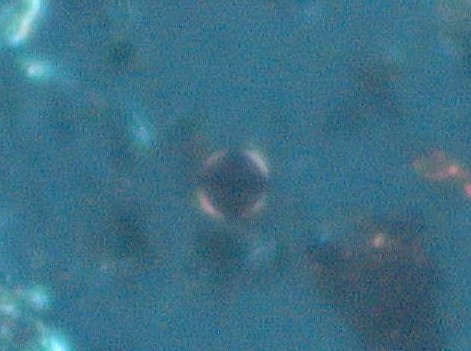Magnetite Sphere
This is a tapelift sample from a shop where welding, torch
cutting, and high-speed grinding of iron is conducted.
The magnetite sphere shows the ring of light on the outside of the particle when it
is viewed with transmitted crossed linear polarized light.
Note the dark areas where the tangent to the sphere is parallel to the polarizing
directions of the polarizing filters.
Transmitted Crossed Polarized Light Illumination
Definition/Function:
Magnetite is Fe3O4 and is cubic in crystal habit all though
octahedral {111} parting may be evident. Magnetite spheres
may be created by welding, torch cutting, or high-speed abrasive grinding. The spheres
tend to be hollow shells. This significantly reduces
the bulk density of these particles and explains why they become so widely dispersed in
the environment near a site where
ironwork is or has been occurring.
Significance in the Environment:
The presence of magnetite spheres generally indicates that welding, iron torch-cutting,
or high-speed abrasive forming (grinding) of iron is
occurring in the nearby environment. They are also formed in much smaller quantity by a
flint-type lighter.
Characteristic Features:
Magnetite spheres are opaque but because of their electrical conductivity they are
surrounded by a bright ring broken by dark spaces where the
tangent to the sphere is parallel to the polarizing filters. When viewed with reflected
darkfield illumination the ring of light from the
darkfield illuminator is reflected back from the sphere. The reflected ring of light is
slightly diffuse because of the "hieroglyphic" texture
of the surface of the sphere. Soot, cenospheres, toner, spores, and other non-conductive
black spheres don't show the bright ring of light at
the edge of the particle when viewed with transmitted crossed polarized light.
Associated Particles:
Weld slag, abrasives, hematite spheres, heat-treat scale, and rust (limonite, goethite,
lepidocrocite, and hematite) are common associates near
the source of the magnetite spheres. Magnetite spheres tend to travel farther from the
source than these particles so the associates become
less common the further from the source.
References:


